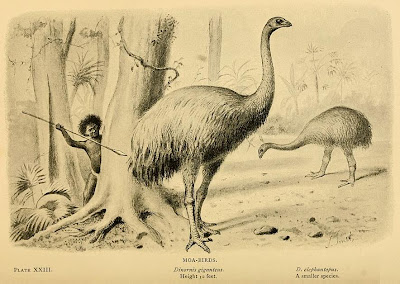 |
| 'Hunting Moa' from Extinct Monsters: A popular account of some of the larger forms of ancient animal life 1892. Note: Pachyornis elephantopus is the valid name of D. elephantopus |
Abstract
The largest extinction event in the Holocene occurred on Pacific islands, where Late Quaternary fossils reveal the loss of thousands of bird populations following human colonization of the region. However, gaps in the fossil record mean that considerable uncertainty surrounds the magnitude and pattern of these extinctions. We use a Bayesian mark-recapture approach to model gaps in the fossil record and to quantify losses of nonpasserine landbirds on 41 Pacific islands. Two-thirds of the populations on these islands went extinct in the period between first human arrival and European contact, with extinction rates linked to island and species characteristics that increased susceptibility to hunting and habitat destruction. We calculate that human colonization of remote Pacific islands caused the global extinction of close to 1,000 species of nonpasserine landbird alone; nonpasserine seabird and passerine extinctions will add to this total.
Keywords: endemism, human impact, island biogeography, zooarchaeology, avifauna
 |
Paleo Art of Heinrich Harder
*Unfortunately, poor Heinrich Harder seems not to have known that the Maori did not use bows and arrows.
|
Humans killed over 10 percent of the world’s bird species when they colonized the Pacific Islands
Around 4,000 years ago intrepid Polynesian seafarers made their way into an untamed wilderness: the far-flung Pacific Islands. Over a thousands or so years, they rowed from one island to another, stepping on shores never yet seen by humans. While this vast colonization brought about a new era of human history, it also ended the existence of well-over a thousand bird species according to a new study in the Proceedings of the National Academy of Sciences (PNAS).
Scientists have long known that the arrival of people on these remote wildernesses brought about extinctions—such as the duck-like moa-nalos in Hawaii—but have had difficulty estimating the full-scale of the avian extinction.
"Relatively few fossils have been collected from most islands that have been studied," the scientists write. "Consequently, many extinct bird species remain to be discovered, confounding attempts to quantify more precisely the number and type of species lost across the region."
But employing sophisticated modeling techniques, a team of international scientists were able to bridge the gaps in the fossil record and estimate just how many bird species may have vanished.
"We studied fossils from 41 tropical Pacific islands and using new techniques we were able to gauge how many extra species of bird disappeared without leaving any trace," explains co-author Tim Blackburn, Director of the Zoological Society of London's (ZSL) Institute of Zoology. "If we take into account all the other islands in the tropical Pacific, as well as seabirds and songbirds, the total extinction toll is likely to have been around 1,300 bird species."
The birds succumbed to a combination of deforestation and hunting. The largest group of victims were non-passerine land birds, including waterfowl, pheasants, and grouse. In the absence of predators, many of these species had probably lost the ability to fly making them easy meals for the Polynesians. In fact, the study found that flightless birds were 33 times more likely to vanish with the arrival of human super-predators. In addition, birds found on only a single island (endemics) were 24 times more likely to go extinct.
"Species endemic to isolated islands often lose behavioral responses to mainland predators, making them tame and easy to hunt when humans arrive," the researchers write.
The extinction event was by no means minor. If the researchers' estimate of 1,300 species proves correct, it would mean over 10 percent of the world's birds vanished within a few hundred years. Currently, around 10,000 birds survive around the world.
The wave of extinctions continued long after the Polynesians settled into their new homes. The arrival of Europeans killed off another 40 or so species, including the famous dodo (Raphus cucullatus) on Mauritius, although in the Indian Ocean this was also colonized by Polynesians. Today many of the bird survivors on Pacific Islands remain hugely imperiled, such as the Manumea (Didunculus strigirostrisor), also known as the "little dodo," which may be down to less than 200 birds on Samoa.
 |
| 'Hunting Moa' from Extinct Monsters: A popular account of some of the larger forms of ancient animal life 1892. Note: Pachyornis elephantopus is the valid name of D. elephantopus |
Richard Duncan, Alison Boyer, and Tim Blackburn. 2013. Magnitude and variation of prehistoric bird extinctions in the Pacific. PNAS. http://www.pnas.org/content/110/16/6436
Humans killed over 10 percent of the world’s bird species when they colonized the Pacific Islands